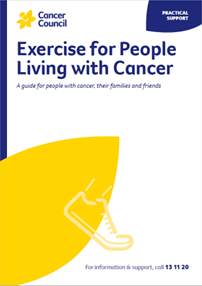- Home
- About Cancer
- Living well
- Exercise for people living with cancer (with videos)
- Getting started
- Tips for starting an exercise program
Tips for starting an exercise program
Find an exercise program that you enjoy, and that matches your current fitness level. Ask your health professional what activity is best for you and your ability.
Being at homeHome-based exercise can be the easiest to start with. You can try some strength or resistance training exercises at home | |
Try outdoor activitiesBeing active outdoors is a good way to add physical activity and exercise into your daily routine. You could try walking, riding a bike or swimming. | |
Join a group exercise programMany gyms and fitness centres run group exercise programs. When joining, let your gym know that you have or are recovering from cancer, and ask if they have someone who can check whether the exercise program is right for you. Ideally, an exercise physiologist or physiotherapist will assess your health and fitness and tailor a program to your needs. Your cancer centre may offer classes designed for people with cancer. | |
Do incidental activityMove more throughout the day. You could walk or ride to the shop or hospital, or take the stairs. The important thing is to try and be active most days of the week. | |
Find equipmentActivity monitors, hand weights, heart rate monitors and home-gym systems can be useful but aren’t necessary. You can add exercise equipment into your program at little to no expense. For example, a step is a great aerobic and resistance training device. A backpack filled with a bag of sand makes for a good piece of resistance training equipment. | |
Choose what to wearYou don’t need to buy expensive equipment or special clothing to do exercise, but the correct shoes are need for walking or jogging. Visit a reputable shoe shop for suggestions to suit you and your healthconcerns. You may like loose, comfortable clothes, such as shorts and a T-shirt, when exercising. Or you may find close-fitting or supportive tights and a top are best for some exercise. | |
Mix things upTry to include aerobic and cardio exercises as well as strength and resistance training in your weekly exercise program. Doing a combination of different types of exercise helps to improve more areas of your health and fitness. |
→ READ MORE: Planning an exercise session
Video: Exercise and cancer
Podcast: Meditation and Relaxation
Listen to more of our meditation and relaxation podcast for people affected by cancer
More resources
Kirsten Adlard, Accredited Exercise Physiologist, The University of Queensland, QLD; Dr Diana Adams, Medical Oncologist, Macarthur Cancer Therapy Centre, NSW; Grace Butson, Senior Physiotherapist, Peter MacCallum Cancer Centre, VIC; Kate Cox, 13 11 20 Consultant, Cancer Council SA; Wai Yin Chung, Consumer; Thomas Harris, Men’s Health Physiotherapist, QLD; Clare Hughes, Chair of Cancer Council’s Nutrition, Alcohol and Physical Activity Committee; Jen McKenzie, Level 1 Lymphoedema Physiotherapist, ESSA Accredited Exercise Physiologist, The McKenzie Clinic, QLD; Claudia Marck, Consumer; Dr David Mizrahi, Accredited Exercise Physiologist and Research Fellow, The Daffodil Centre at Cancer Council NSW and The University of Sydney, NSW; Prof Rob Newton, Professor of Exercise Medicine, Exercise Medicine Research Institute, Edith Cowan University, WA; Jason Sonneman, Consumer.
View the Cancer Council NSW editorial policy.
View all publications or call 13 11 20 for free printed copies.

